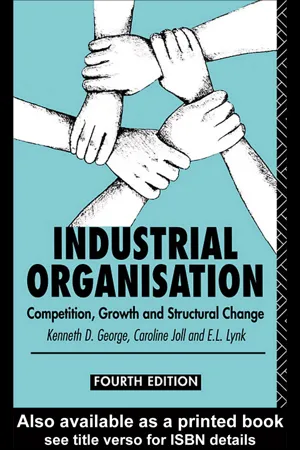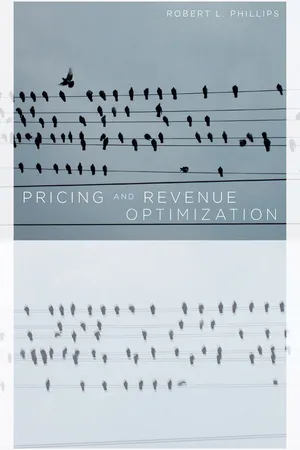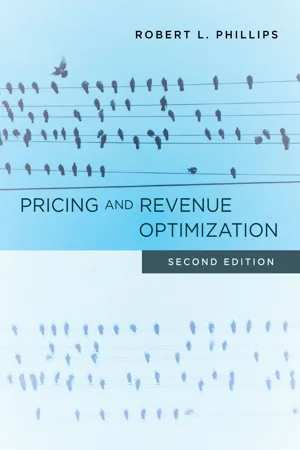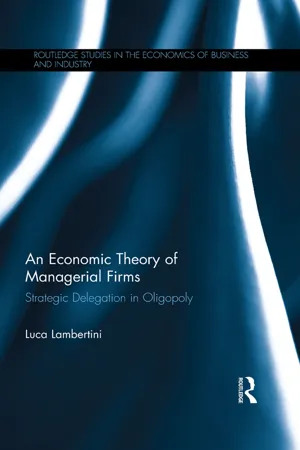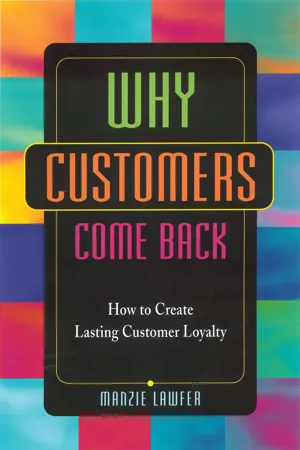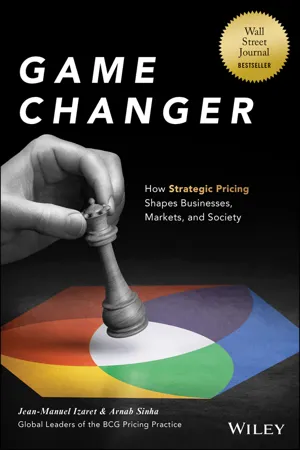Economics
Product Differentiation
Product differentiation refers to the strategy of distinguishing a product from its competitors through unique features, branding, or marketing. This can include variations in design, quality, or functionality, creating a perceived value that sets the product apart in the market. By differentiating their products, companies aim to attract customers and build brand loyalty.
Written by Perlego with AI-assistance
Related key terms
Related key terms
1 of 4
Related key terms
1 of 3
11 Key excerpts on "Product Differentiation"
- eBook - ePub
Industrial Organization
Competition, Growth and Structural Change
- Kenneth George, Caroline Joll, E L Lynk(Authors)
- 2005(Publication Date)
- Routledge(Publisher)
Chapter 8
Product Differentiation
8.1 INTRODUCTION
In this chapter we turn from oligopolistic pricing to an aspect of non-price competition which can be very important in oligopolistic markets. In contrast to the perfectly competitive model in which a large number of sellers all produce exactly the same product, in an oligopoly the firms typically produce differentiated or heterogeneous products and are thus able to compete by varying the characteristics of their products as well as, or indeed instead of, changing their prices.Product Differentiation refers to a situation in which two or more products are perceived by consumers to be close, but not perfect, substitutes. This is a very broad definition, and two types of Product Differentiation are usually distinguished and analysed separately. Horizontal differentiation (product range) occurs when a market contains a range of similarly priced products. An increase in the range of products means that consumers will, on average, be able to find a product which meets their preferences more exactly. With vertical (or quality) differentiation the products differ in respect of quality and there is agreement on the ranking of the products; buyers differ, however, in their willingness to pay for more quality. The scope for horizontal Product Differentiation, in particular, is greater in consumer than in producer goods industries and the definition of Product Differentiation shows the importance of consumers’ perceptions to this phenomenon. Product. differentiation can have a subjective dimension in that packaging or presentational variations can cause consumers to overestimate the difference between brands.In fact, the concept of Product Differentiation is a subtle one and a full understanding of what is meant by Product Differentiation shows how ubiquitous the practice is. ‘New’ theories of consumer behaviour have analysed consumption as a form of productive process in which the household combines commodities in order to produce a desired mix of characteristics (Lancaster 1966) or combines bought commodities with time inputs in order to produce a desired mix of activities (Becker 1965). Because differentiated products may be seen as combining the same characteristics in different proportions, Lancaster’s model has been widely used to analyse Product Differentiation, as we shall see in section 8.2 below. However, Becker’s model also suggests some less obvious forms of Product Differentiation, because the purchased good represents only one differentiation in the other inputs such as time or amount of service offered. Thus, for instance, corner shops usually charge higher prices than supermarkets for the same products, but the local shops can be reached more quickly and cheaply and are often open longer hours. - eBook - ePub
Industrial Organization
Theory and Practice
- Don E. Waldman, Elizabeth J. Jensen(Authors)
- 2019(Publication Date)
- Routledge(Publisher)
Chapter 10 Product DifferentiationProduct Differentiation has been and will be a recurring topic throughout this text. Product Differentiation is associated with possible advantages for incumbent firms. These advantages include increased economies of scale, possible cost advantages for incumbents, and an increase in the capital barrier to entry. This chapter expands on our previous analysis and emphasizes the theoretical impact of Product Differentiation. Product Differentiation is often closely associated with its complementary topic: advertising. Chapter 11 expands on the general topic of Product Differentiation by considering how advertising impacts economic welfare.10.1 Forms of Product Differentiation
The objective of Product Differentiation is to increase profits by increasing demand and decreasing the price elasticity of demand. Sellers attempt to differentiate their products in many ways. Common forms of differentiation include location, service, physical characteristics, and subjective image differences.Here is an example of location differentiation:1 In Syracuse, New York, one cinnamon bun franchiser had two identical stands located in different malls. One stand was in an upscale mall and was usually busy. The other stand was located on the lower-level of a lower-quality mall and rarely seemed to be crowded. One franchise appeared to be a great success while the other floundered and went out of business. Such examples are common and support the adage that business success depends first and foremost on “location, location, location.” Professional sports franchises are another good example of the importance of location. Franchises in big markets are worth significantly more than franchises in smaller markets.2In addition to location, products are differentiated by service. Some firms offer high-quality service, usually at a high price. Others offer little or no service at low prices. If a consumer purchases a computer from a local computer store and something goes wrong, the dealer may send a representative to fix the problem. If a consumer purchases the same computer from a discount warehouse such as Costco or Sam’s Club and has a problem, she may be on her own with an 800 telephone number or an online chat as her only source of help. Many consumers are willing to pay a price for better service. Sears dominated the market for major household appliances for many years, not because the company sold better washers, dryers, and refrigerators, but because in days of old the company moto was: “Sears Services What It Sells.” IBM’s market power in computers from 1960 to 1985 was also built on the company’s reputation for solving its customers’ problems quickly and efficiently. Other examples of high-price, high-quality-of-service stores include Nordstrom’s, Neiman Marcus, Williams-Sonoma, and Tiffany’s Jewelry. - eBook - ePub
- George Avlonitis, Paulina Papastathopoulou(Authors)
- 2006(Publication Date)
- SAGE Publications Ltd(Publisher)
Alderson (1965) has attempted to provide the link between the concept of differential advantage and the economy as it actually exists. Alderson has noted that differentiation in a product’s characteristics gives a seller control over the product with that exact identity and configuration, supporting the view that ‘the seller offering a product different from others actually does occupy a monopoly position in that limited sense’. However, Product Differentiation can be based on product characteristics such as patented features, trademarks, packaging (for example, design, colour, style) (Alderson, 1965).It is, however, the existence of varied wants and needs in the market place that allows competition through Product Differentiation and a policy of differential advantage to be pursued. Alderson asserts that, behind the acceptance of differentiation are differences in taste desires, income, location of the buyers, and the uses of commodities. Smith (1956) also notes that the seller pursues a policy of differential advantage in general, and Product Differentiation in particular, in order to meet both competitive activities and the various needs and wants in the market place. However, the seller can pursue a policy of Product Differentiation, either by offering the same product throughout the whole market and secure a measure of control over the product’s demand by advertising and promoting differences between his/her product and the product’s of competing sellers, or by viewing the market as a number of small homogeneous markets (market segments) each having different product differences and adjusting the product and the elements surrounding its sale according to the requirements of each market segment. The seller who adopts the latter method in pursuing a policy of Product Differentiation, is actually pursuing a policy of market segmentation.However, a policy of differential advantage must be dynamic in nature since the seller must continually adjust his/her ‘total offering’, to match the ever changing competitive activities and customers’ ‘motivation mixes’ in the market place. Naturally, such adjustments alter the seller’s cost structure and profitability. The seller therefore must be constantly engaged in creating a ‘total offering’ from all the elements under his/her control, in a way that will give differential advantage and profitability. This ‘axiom’ has led to the development of the marketing mix concept.1 - eBook - ePub
The Accidental Marketer
Power Tools for People Who Find Themselves in Marketing Roles
- Tom Spitale, Mary Abbazia(Authors)
- 2014(Publication Date)
- Wiley(Publisher)
find that difference.”Eureka! In a single statement, Ginny had helped us find a new way to describe our firm’s value proposition: we help companies of all types be different from their competitors.We believe that being meaningfully different—creating differentiation—is the very reason for the existence of the marketing function itself. If customers don’t perceive any difference at all among products in a category, they usually choose the lowest-priced product or service. Marketing plays a very limited role in a price war.But people buy products that aren’t the lowest priced all the time. And this is because they perceive that the higher-priced product or service has some explicit or inherent advantage, a difference, that warrants a higher price. Developing this difference is marketing’s primary job.Differentiation strategies can come from many different aspects of a strong marketing plan. Indeed, our previous chapters have shown you how you can distinguish your products by finding new, underserved stakeholders, or uncovering unspoken customer benefits sought, or segmenting creatively, or targeting specifically with discipline.But now you have reached the point in the marketing process when you are ready to get very specific about differentiation strategies. Whether you are ahead or behind in your Ability to Win, you can’t stand still. You are about to learn three powerful ways to uncover strategies that allow your company to stand out among your competitors and gain higher sales and profits. Viva la differentiation!Innovate to Differentiate: Three Strategies That Emanate from Your Ability to Win Analysis
You may be wondering how the concept of differentiation compares with another hot topic in business today: innovation. Differentiation in marketing is the act of proving to customers that a product or service has an important difference when compared with competitors. Innovation without differentiation—that is, new inventions that don’t meet customer needs better - eBook - ePub
- Robert Phillips(Author)
- 2005(Publication Date)
- Stanford Business Books(Publisher)
4
PRICE DIFFERENTIATION
In this chapter we treat one of the most fundamental concepts in PRO—price differentiation . Price differentiation refers to the practice of a seller charging different prices to different customers, either for exactly the same good or for slightly different versions of the same good. Price differentiation is a powerful way for sellers to improve profitability. It also adds a new level of complexity to pricing, often creating a need to use analytical techniques to improve the calculation and updating of prices over time.We use the term price differentiation to refer to the ways that additional profit can be extracted from a marketplace by charging different prices. Tactics for price differentiation include charging different prices to different customers (or groups of customers) for exactly the same product, charging different prices for different versions of the same product, and combinations of the two. The term price discrimination is used in the economics literature to refer to much the same thing. We use the term price differentiation , rather than the more common price discrimination , in part to avoid the negative connotations associated with the word discrimination . However, we also want to stress that price differentiation includes not only charging different prices to different customers for the same product (group pricing) but also the less controversial strategies of product versioning, regional pricing, and channel pricing.There is both art and science to price differentiation. The art lies in finding a way to divide the market into different segments such that higher prices can be charged to the high-willingness-to-pay segments and lower prices to the low-willingness-to-pay segments. There is no one way to segment customers that applies to all possible markets. Instead, there is a variety of techniques that can be applied in different ways, depending on the characteristics of a market, the competitive environment, and the character of the goods or services being sold. The science lies in setting and updating the prices in order to maximize overall return from all segments. - eBook - ePub
Pricing and Revenue Optimization
Second Edition
- Robert L. Phillips(Author)
- 2021(Publication Date)
- Stanford Business Books(Publisher)
6 PRICE DIFFERENTIATIONIn this chapter we examine one of the most fundamental concepts in pricing and revenue optimization—price differentiation . Price differentiation refers to the practice of a seller charging different prices to different customers, either for exactly the same good or for slightly different versions of the same good. It can be a powerful tactic for sellers to improve profitability. It also adds a new level of complexity to pricing, often driving the need to use analytical techniques to improve the calculation and updating of prices over time. Price differentiation can also be dangerous if not managed correctly—it can lead to loss of profit through arbitrage and to negative reactions to pricing that some customers may perceive as unfair.Tactics for price differentiation include charging different prices to different customers (or groups of customers) for exactly the same product, charging different prices for different versions or amounts of the same product, and combinations of the two. It also includes charging different prices for combinations of products than for individual products sold separately. I use the term “price differentiation” rather than the standard economic term price discrimination in part to avoid the negative connotations associated with the word “discrimination.” However, I also want to stress that price differentiation includes not only charging different prices to different customers for the same product (group pricing) but also the less controversial strategies of product versioning, regional pricing, channel pricing, and nonlinear pricing.While “price differentiation” and “dynamic pricing” are often used interchangeably, there is an important distinction between the two concepts. Price differentiation refers to strategies for charging different prices to different customers based on differences in their willingness to pay. Price differentiation usually (but not always) means that different prices are in play for the same (or very similar products) at the same time. Dynamic pricing, on the other hand, refers to changing the price of a product over time. Dynamic pricing is often employed to balance supply and demand—as in the case of the variable-pricing approaches discussed in Chapter 7 - eBook - ePub
Commercial Due Diligence
The Key to Understanding Value in an Acquisition
- Peter Howson(Author)
- 2016(Publication Date)
- Routledge(Publisher)
requirements underlie all of these, so when trying to work out what is going on in a market, always start with the customers. All segmentation starts with customer needs. Products are sources of satisfaction to consumers and this is the only way to think of them. Products and services should therefore be analysed in terms of the way they are perceived by customers in relation to:- why they buy one product rather than another; and
- competitive offerings.
There are four approaches any company can take to marketing a product or service. These are set out in Figure 3.1Recognizing which companies are following which approach is a good first step in defining market boundaries, but more on that in a moment.Figure 3.1 Levels of marketing segmentationDifferentiation and segmentation are two totally different things …
Differentiation involves:- concentration on one or more key criteria which are valued by customers;
- adding costs selectively in the areas perceived to be important to acquirers and charging a premium price in excess the costs added.
The success of this strategy lies in finding opportunities for differentiation that cannot be matched by competitors while being clear about the costs involved and the amount of the price premium that can be charged. Differentiation means working out the product, service, and image characteristics that influence customer choice and positioning your production to appeal to a selection of them. Differentiation is not the same as segmentation, but differentiation is closely linked to choices over the segments in which a firm competes. Unique offerings may mean that a firm ends up targeting only certain market niches.The term ‘segmentation’ appears to have been first coined by Wendel Smith1 in the 1950s. He came at it from the perspective of a single product company that could either aim to secure a ‘share of a broad and generalized market’ through Product Differentiation or aim for ‘depth of market position in the segments that are effectively defined and penetrated’ through market segmentation. Philip Kotler2 - eBook - ePub
An Economic Theory of Managerial Firms
Strategic Delegation in Oligopoly
- Luca Lambertini(Author)
- 2017(Publication Date)
- Routledge(Publisher)
7 Endogenous Product DifferentiationWhile so far Product Differentiation has appeared here and there in the form of the preference for variety of a representative consumer, this chapter focuses on the bearings of Product Differentiation formulated from the specific viewpoint of discrete choice theory (Anderson et al., 1992), where a continuum of consumers differ for some specific features (willingness to pay or location in a well behaved preference space) and express unit demands for their preferred variety of a good whose characteristics are endogenously chosen by firms for strategic reasons.Ever since its early stages, the theory of industrial organization has viewed Product Differentiation as a means to soften market competition, in particular price competition. Discrete choice theory obviously shares this flavour (see Gabszewicz and Thisse, 1979, 1980, and Shaked and Sutton, 1982), combining it with a renovated attention for the properties of the entry process, in whose connection the so-called finiteness property has been characterized (Shaked and Sutton, 1983).The relevance of granting differentiation its proper strategic nature deserves a few more words, and perhaps can be best appreciated through a more concrete example. Confining ourselves to the effects of endogenous Product Differentiation on price competition, it is worth dwelling upon a recurrent idea which may sound sensible to the casual observer but might also haunt the dreams of managers and stockholders (and in fact it has done so several times), namely, that imitating a successful product could be a fruitful strategy, especially if that product relies on secrecy rather than patent protection. Whether this turns out to work or not, essentially depends on consumers’ brand loyalty, be that motivated or not by objective considerations. The story of several industries, such as, for instance, that of soft drinks or clothing, provides plenty of examples in either direction, while the seminal debate on the so-called minimum or maximum differentiation principles (Hotelling, 1929; d’Aspremont et al., 1979) decidedly claims that firms should keep off from each other as much as possible in order to soften price competition and increase profits, much the same way as they would by sustaining implicit or explicit cartel behaviour with similar or identical products. In view of the managerial inclinations we have become accustomed to in earlier chapters, this prescription should be expected to apply a fortiori - eBook - ePub
Essentials of Pricing Analytics
Tools and Implementation with Excel
- Erik Haugom(Author)
- 2020(Publication Date)
- Routledge(Publisher)
Chapter 3Segmentation and price differentiation
When firms face finite customer responses from price changes, they have market power. This means that they can set prices more freely compared with firms operating in markets recognized by perfect competition. The question the managers of such firms must ask is how they can use their market power to maximize profit. One important answer to this question is that they should look for ways of charging different prices for, more or less, the same product or service offered to the market. That is, firms should look for ways to price differentiate based on certain criteria . Identifying the certain criteria that can be used to price differentiate is often referred to as segmentation . Price differentiation and segmentation are at the heart of pricing analytics in general, and variable pricing specifically. This chapter is devoted to explaining the theory and practice of these concepts and why firms (always) and customers (sometimes) should both be eager to have more of it. The following topics will be covered:• Definitions and degrees of price differentiation.• The economics theory behind price differentiation.• Ways to segment and price differentiate in practice.• Challenges of segmentation and price differentiation.The calculations of optimal differentiated prices and the implementation of this practice in Excel will be presented in later chapters. In this chapter we limit the Excel implementation to simple examples that illustrate the impact from various approaches to price differentiation on profit.3.1 Price differentiation defined
Price differentiation can be defined as:A given firm can perform price differentiation if it:“The practice of charging different prices for identical or similar goods or services based on certain criteria.” 11. Can identify at least some variation in the maximum price its customers are willing to pay for the product or service of interest. This maximum price is called the reservation price. - eBook - ePub
Why Customers Come Back
How to Create Lasting Customer Loyalty
- Manzie R, Lawfer(Authors)
- 2003(Publication Date)
- Career Press(Publisher)
Chapter 4
Differentiation
In Chapter 2 , I described an exercise I ask my audience to participate in at the workshops and seminars I conduct. The audience discovers that customer satisfaction has little to do with their buying habits. The exercise demonstrates that many times customers are loyal even when they aren't satisfied. So why do people shop where they do?People buy what they buy where they buy it because of the value of the product or service; don't confuse value and price. Price is only one part of value. The differences in location, color, selection, service, style, and a million other things are all differentiators in products and services. These differences provide superior value and cause someone to trade with the people they do.Differentiators make one business, product, or seller distinguishable from another. Through differentiation you are demonstrating why your customers should do business with you instead of your competitor. If there is no difference between you and the competition, your customers have no reason to choose you over the other guy.There Is Competition for Every Sale
There is an element of competition for every purchase and sale. Sometimes the competition is between two or more sellers for a similar product. A buyer is considering the purchase of a computer from either a major retailer or a local computer shop. In real estate, the buyer is considering the purchase of a piece of property. There is only one property that interests the buyer, but she may be considering which real estate agent she would like to represent her. Other times several products from different sellers are being considered. An automobile shopper might be considering a Ford, Chevrolet, or Chrysler all from different dealerships. In some situations it's not a matter of vendors, specific products, or salespeople competing for the sale of similar or competing product, but, instead, there is competition with other potential uses of our money or capital. In order to win, you have to not only illuminate what makes your solution or product most appealing, but also make the competing product or service adverse, not as attractive, or risky. This process of competition and the buyer's final decision is always based on differentiators. - eBook - ePub
Game Changer
How Strategic Pricing Shapes Businesses, Markets, and Society
- Jean-Manuel Izaret, Arnab Sinha(Authors)
- 2023(Publication Date)
- Wiley(Publisher)
Price differentiation: This framework lies at the intersection of competition and value, because a company can differentiate prices relative to competitors and relative to its own products. This framework combines insights from the economic theories of price discrimination and behavioral science. Price discrimination refers to selling the same offer to different customers at different price points, either directly (first‐degree price discrimination) or through discounts (second‐ and third‐degree discrimination). We think this perspective is too restrictive from a practical standpoint. That is why our definition of differentiation is broader: the combination of price discrimination and behavioral science. In other words, differentiation means price variation and product variation. Behavioral science studies how customers choose among a company's various offers. It has highlighted numerous biases that humans have when making such choices. These biases transcend and often contradict the numerical rationality of classical economics.Game theory:The game theory framework lies at the intersection of costs and competition, because a company only needs costs and competitor price information to define optimal prices in that framework. It applies primarily when a company's prices depend on the pricing behavior of a few individual competitors whose offerings all have very similar value. In such circumstances, the game theory framework helps leaders make better‐informed unilateral moves, because they understand the effects those moves will have on competitors and on their own company.The role of elasticity
Price elasticity of demand is a dimensionless number defined as the percentage change in volume divided by the percentage change in price. Following that mathematical definition strictly, the elasticity is negative, because higher prices generally lead to lower volumes and lower prices to higher volumes. In practice, it is more intuitive to consider the absolute value and refer to the elasticity as a positive number. This avoids confusion when talking about a high or low elasticity.
Index pages curate the most relevant extracts from our library of academic textbooks. They’ve been created using an in-house natural language model (NLM), each adding context and meaning to key research topics.
Explore more topic indexes
Explore more topic indexes
1 of 6
Explore more topic indexes
1 of 4
